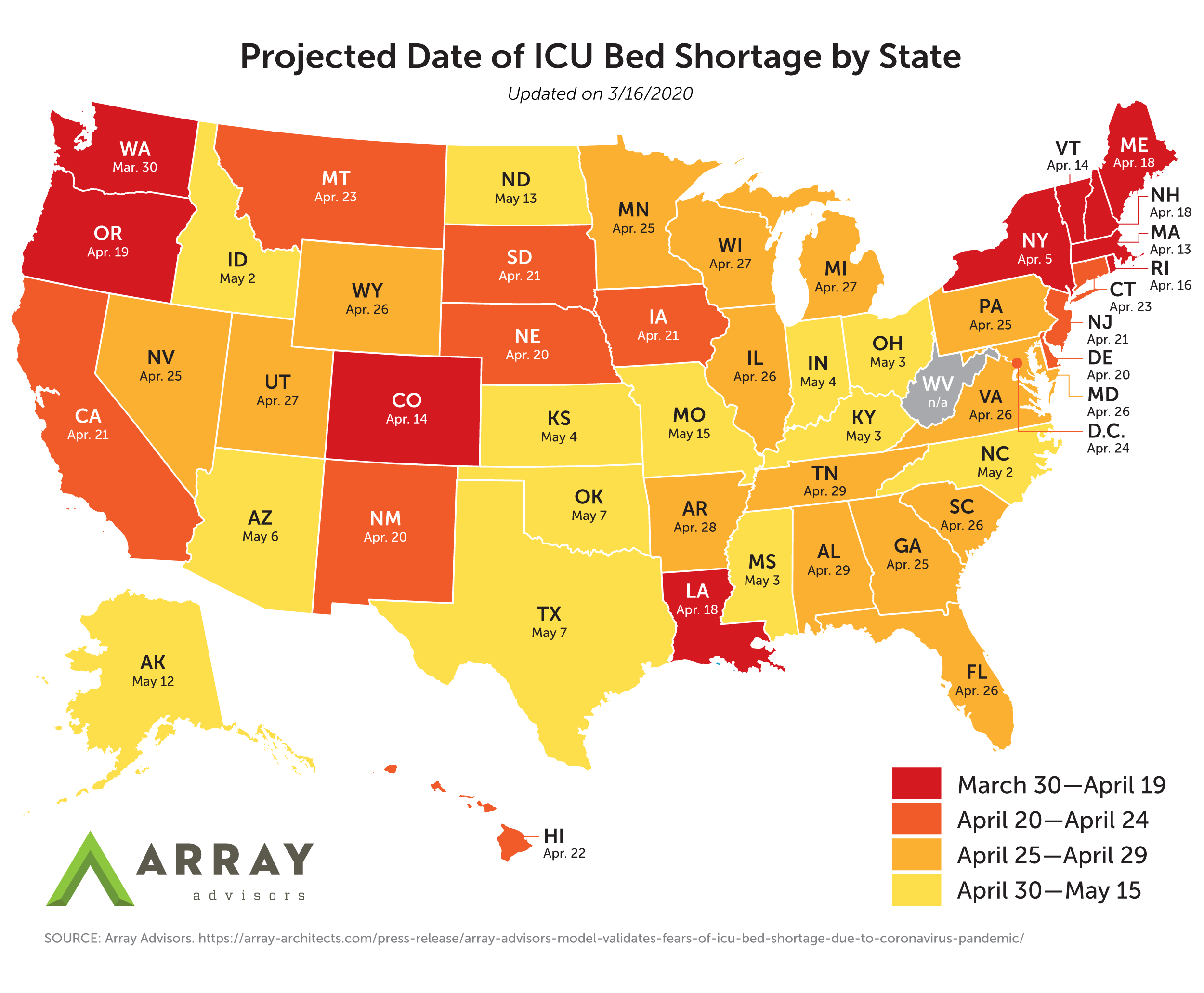Industry Experts Predict Dates for Imminent Bed Deficit in Key States
Washington, DC – Array Advisors has built a model that projects the availability of U.S. hospital beds as the coronavirus pandemic grows. The model validates fears that a shortage of beds may occur unless efforts to expand hospital capacity are implemented immediately.
Even if hospitals were to cancel all elective surgeries, the analysis suggests that there will be no available beds in intensive care units (ICUs) in the U.S. by the end of April, and beds in medical-surgical units will reach full occupancy by mid-May. If the virus spreads faster than the model projects, or if hospitals do not cancel elective cases, these capacity deadlines may be even closer.
However, the national models hide wide variations in bed capacity and anticipated need. At the state level, the supply of staffed beds and number of confirmed cases both vary significantly, as does the prevalence of the high-risk demographic aged 65 and over. Reports from China’s Hubei Province and Northern Italy suggest radically different rates of hospitalization (20% vs. 50%) correlated to their respective over-65 populations (12% vs. 23%). Based on this knowledge, Array Advisors has modified its model to reflect each state’s unique circumstances. The result: the state of Washington, with the highest number of confirmed cases to date, is projected to run out of ICU beds by April 1st and medical-surgical beds by mid-April. Meanwhile, Utah, a state with a younger population and relatively fewer confirmed cases to date, will have ICU beds available until the end of April and med/surg beds will run out two weeks later.
Download a table from the model with deadlines by state here, or get the entire model with instructions for generating day-to-day projections by selecting one state at a time here.
The analysis emphasizes the narrowing window of time left for all states to expand their capacity to care for patients requiring hospitalization. While these numbers may be alarming, they intensify the healthcare industry’s call for urgent action.
The Array Advisors team is aware that some efforts to expand capacity are already underway in the hardest-hit states. State and local authorities have taken steps to coordinate with hospitals and providers to make extra beds available. New York, for example, has announced plans to accommodate an additional 1,100 patients. The Cleveland Clinic is looking to convert a nearby hotel to create more bed capacity. We are also hopeful that the funds released by the President’s emergency declaration will be used to redeploy underutilized beds in Veterans Affairs and military hospitals. However, many regions do not possess reserves of beds to activate in times of extraordinary need, and if they do, they will also need sufficient staff and equipment to match.
The step that most hospitals can and should take now: cancel elective surgeries, which some have, but many other have not. This includes the vast majority of joint replacements, bariatric procedures, spinal surgeries, and even elective cardiac procedures for patients who could be treated medically. This drastic measure will inconvenience patients who are suffering and will, in some cases, pose a real clinical risk, but it appears that health systems have no choice but to start taking those calculated risks today. This will put significant economic stress on hospitals and health systems; hopefully future federal stimulus will include provisions to ensure organizational sustainability. This will not only make more beds available, but it will also ensure that staff will be available to provide the type of care necessary to support critical need patients. American’s world renown specialists of today may need to be the ER doctors and hospitalists of tomorrow.
Array Advisors created this model to quantify the current need for action and to start a conversation about how America’s healthcare system could build better resilience to future pandemics. Hospitals today are built to run lean, even if that means boarding sick patients in corridors during peak flu season. Old hospitals are almost always torn down. Infectious disease departments are underfunded and poorly staffed compared to other specialties. Nurse shortages are solved with short-term, mobile labor. None of this can be the model for tomorrow’s resilient health care system.
The industry needs to imagine how leveraging our military’s facilities and its thousands of medics could provide surge assistance during pandemics. Health systems may need to consider preserving spaces abandoned by other industries and devise ways to rapidly repurpose them as screening sites or to provide surge capacity. As a nation, we may need to think about how to create a national reserve healthcare workforce that can upskill in an emergency. These are only a few potential solutions, but Array Advisors is eager to generate more during the impending debate over how to survive not only this pandemic, but all that follow.
About Array
Recognized as a leader in healthcare facility design, consulting and technology, Array offers knowledge-based, data-informed services, including planning, architecture, interior design, transformation and asset advisory services. Using Lean as a foundation for a unique process-led approach, Array’s deliverables use data and technology to leverage real-time patient and real estate market trends required by today’s healthcare organizations. The company’s devotion to a healthcare-exclusive practice springs from the belief in the power of design and technology to improve patient outcomes, maximize operational efficiencies, and increase staff satisfaction.
***
Media Contact
Craig Meaney
Communications Manager
610-755-6488
@ArrayArch
cmeaney@array-architects.com





